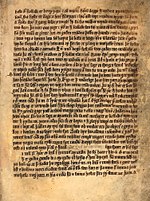Ole Worm (13 May 1588 – 31 August 1654), who often went by the Latinized form of his name Olaus Wormius, was a Danish physician, natural historian and...
13 KB (1,261 words) - 18:45, 14 May 2024
This frontispiece by Ole Worm titled Ole Worm’s Cabinet of Wonder: Natural Specimens and Wondrous Monsters is an engraving depicting various animal taxidermy...
9 KB (1,071 words) - 02:01, 11 March 2023
Runicus - was published in 1626 by the Danish physician and antiquarian Ole Worm (Olaus Wormius) (1588–1654). The text consists of the 12 calendar pages...
3 KB (344 words) - 21:50, 19 March 2024
politician Ole Stavad, Danish politician Ole Svendsen, Danish boxer Ole Tinghaug, Norwegian politician Ole Worm, Danish physician and antiquary Eduard Ole (1898–1995)...
2 KB (248 words) - 03:46, 11 January 2024
manuscript, originally from 1328, but collected and published by the Dane Ole Worm (1588–1654), uses this futhark notation, and not the pentadic numerals...
6 KB (682 words) - 07:23, 23 August 2023
the horn holds magical and medicinal properties. The Danish physician Ole Worm determined in 1638 that the alleged alicorns were the tusks of narwhals...
42 KB (4,874 words) - 14:01, 6 August 2024
Olaus Wormiaus (Ole Worm) in his posthumous Museum Wormianum (1654) and by another Dane, Thomas Bartholin the senior (1657). Ole Worm classed it as the...
35 KB (2,642 words) - 02:11, 3 August 2024
mission to Barbados. The group portrait painting of Ole Worm and his family is completed. Portrait of Ole Worm and his family. 1 September – Princess Anna Sophie...
1 KB (76 words) - 22:38, 2 March 2023
In Scandinavia, the 17th-century Danish scholars Thomas Bartholin and Ole Worm and the Swede Olaus Rudbeck used runic inscriptions and Icelandic sagas...
216 KB (22,885 words) - 13:22, 6 August 2024
grew in spring. This description was contradicted by natural historian Ole Worm, who accepted that lemmings could fall out of the sky, but claimed that...
19 KB (1,946 words) - 13:57, 5 August 2024
term "stalactite" was coined in the 17th century by the Danish Physician Ole Worm, who coined the word from the Greek word σταλακτός (stalaktos, "dripping")...
18 KB (2,141 words) - 12:48, 11 June 2024
work. In 1706, Árni Magnússon obtained the document from Ole Worm's nephew, Christian Worm. Today it remains part of the Arnamagnæan Manuscript Collection...
3 KB (260 words) - 20:30, 26 October 2023
History of the Scottish People 1560–1830, pp. 184–192 Adam of Bremen and Ole Worm are quoted as maintaining this in Grillot de Givry's Witchcraft, Magic...
35 KB (3,709 words) - 17:06, 7 June 2024
survived long enough to be documented and depicted. When the antiquary Ole Worm (1588–1654) explored the monument, it consisted of eight stones. Five of...
7 KB (790 words) - 21:59, 23 February 2024
1636. Ole Worm succeeds Jesper Rasmussen Brochmand as Rector of the University of Copenhagen. Otto Grote zu Schauen, statesman (died 1693) Ole Worm: Runir...
2 KB (157 words) - 23:50, 23 February 2023
January – The Treaty of Knäred is signed, officially ending the Kalmar War. Ole Worm returns to Denmark joining the University of Copenhagen. Kindleberger,...
1 KB (82 words) - 21:43, 27 May 2023
was documented during the survey of runestones in the 17th century by Ole Worm as being located at Uppåkra, but it was later moved about 200 meters during...
46 KB (7,040 words) - 02:07, 24 February 2024
tvímaður; Golden Number 18), and (belgthor; Golden Number 19). In 1636, Ole Worm documented the Younger Futhark numeral system, including these three characters...
7 KB (717 words) - 16:52, 1 April 2024
Bishop of the Diocese of Bjørgvin to Ole Worm in 1626. Bishop Paaske also provided a drawing of the inscription. Ole Worm was a Danish antiquarian who wrote...
3 KB (340 words) - 17:33, 11 June 2024
the most famously described seventeenth-century cabinets were those of Ole Worm, known as Olaus Wormius (1588–1654) (illustration, above right), and Athanasius...
43 KB (5,179 words) - 12:10, 29 July 2024
In Scandinavia, the 17th-century Danish scholars Thomas Bartholin and Ole Worm and Swedish scholar Olaus Rudbeck were the first to use runic inscriptions...
151 KB (18,294 words) - 17:12, 10 August 2024
professor Boris Worm (born 1969), marine ecologist Christen Worm (1672–1737), Danish bishop Erik Worm (1900-1962), Danish tennis player Ole Worm (1588–1655)...
2 KB (282 words) - 12:12, 10 August 2023
date – Eleanor Glanville, English entomologist (died 1709). August 31 – Ole Worm, Danish physician, natural historian and antiquary (born 1588) October...
2 KB (180 words) - 16:43, 16 June 2024
duct – Kaspar Friedrich Wolff (1733–1794), German physiologist Wormian bones – Ole Worm (1588–1654), Danish scientist Zonule of Zinn – Johann Gottfried Zinn (1727–1759)...
15 KB (1,457 words) - 06:23, 7 August 2024
(1588-1654), Bishop of the Diocese of Stavanger. He had been commissioned by Ole Worm to provide inscriptions from rune stones located from within his diocese...
5 KB (565 words) - 17:35, 11 June 2024
Jens Ferdinand (1997) Bjørn Wiinblad (1986) Niels Winkel (1988) Ole Woldbye (2003) Ole Worm (1988) Troels Wörsel (1993) Christian IX of Denmark (1905) Christian...
6 KB (695 words) - 00:27, 25 June 2024
syndrome Primary acro-osteolysis Down syndrome Wormian bones are named for Ole Worm, professor of anatomy at Copenhagen, 1588–1654. He taught Latin, Greek...
4 KB (389 words) - 19:17, 16 April 2024
Bartholin the Elder (1585–1629), botanist Jørgen Fuiren (1581–1628), historian Ole Worm (1588–1654) and theologian Hans Brochmand (1594–1630). Fincke died at Copenhagen...
3 KB (240 words) - 00:21, 17 March 2024
illegible as early as the 12th century, the Danish physician and antiquary Ole Worm declared in the 17th century that he had managed to read four letters in...
7 KB (892 words) - 04:15, 31 January 2024
Danish and Icelandic historians of subsequent generations, most prominently Ole Worm. In his historical writings Arngrímur had access to texts no longer extant...
6 KB (631 words) - 21:13, 28 May 2024




















